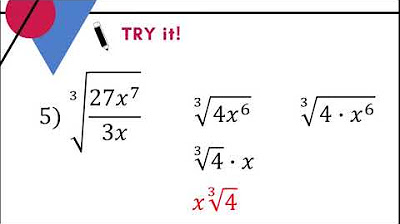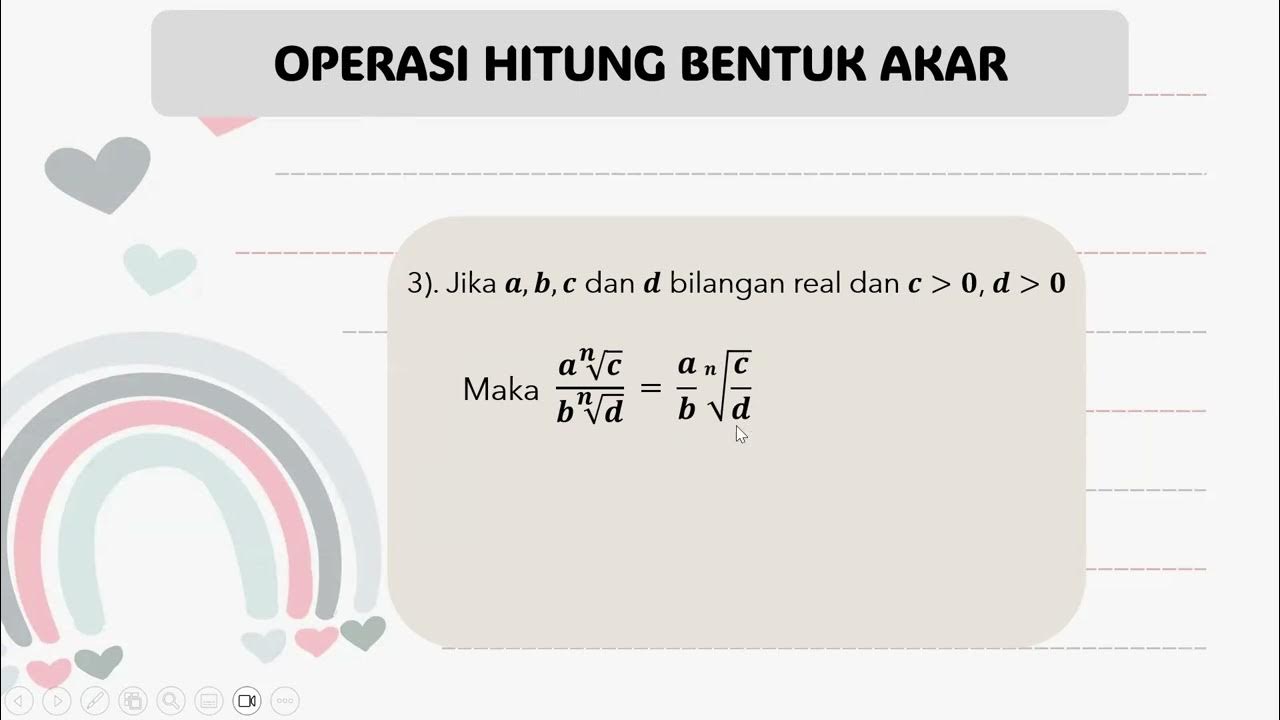Simplifying Radicals With Variables, Exponents, Fractions, Cube Roots - Algebra
Summary
TLDRThis educational video script offers a comprehensive guide on simplifying radicals with variables and exponents. It explains the process of simplifying square roots and higher roots by breaking down the exponents and identifying perfect squares or cubes, using examples like simplifying the square root of 32 and cube root of 16. The script also covers handling expressions with multiple variables and demonstrates the use of absolute values for even indices with odd exponents. It concludes with solving complex radical expressions, emphasizing the importance of rationalizing denominators and simplifying to the most reduced form.
Takeaways
- 📚 The video focuses on simplifying radicals with variables and exponents, providing various methods to achieve this.
- 🔍 Simplifying the square root of a variable raised to an exponent involves breaking down the exponent by the index number, as shown with \( \sqrt{x^5} \) simplified to \( x^2\sqrt{x} \).
- ✂️ Another approach to simplifying radicals is by dividing the exponent by the index to determine how many times the index fits into the exponent and what remains.
- 📉 For radicals with a number, such as \( \sqrt{32} \), the number is broken down into a product of a perfect square and another number, simplifying to \( 4\sqrt{2} \).
- 📶 When simplifying expressions with multiple variables and exponents, such as \( \sqrt{50x^3y^{18}} \), divide the exponents by the index and simplify the radical part separately.
- 💡 The use of absolute values is mentioned for cases with an even index and an odd exponent resulting from the radical simplification, which may be required by some teachers.
- 📐 The cube root of a variable to a certain power can be simplified by dividing the power by the index, as demonstrated with \( \sqrt[3]{x^5} \) becoming \( x^2 \) inside the radical.
- 🔑 Simplifying complex expressions with multiple variables and exponents in the numerator and denominator involves simplifying each part and then combining them, considering the division of exponents.
- 📘 Rationalizing the denominator is necessary when the denominator contains a radical, as shown in the final example where the denominator is multiplied by the radical's conjugate.
- 🔄 The process of simplifying radicals involves breaking down the expression into simpler components, simplifying each part, and then recombining them.
- 🎓 The video concludes by reinforcing the method of simplifying radicals with variables and exponents, emphasizing the importance of understanding the process for various mathematical problems.
Q & A
What is the main focus of the video?
-The video focuses on how to simplify radicals with variables and exponents.
How can you simplify the square root of x to the fifth power?
-You can simplify it by writing x to the power of 5/2, which results in x squared times the square root of x.
What is the method to determine how many times the index number goes into the exponent when simplifying radicals?
-You divide the exponent by the index number to see how many times it goes evenly, and then determine the remainder to simplify the radical.
How is the square root of 32 simplified in the video?
-It is simplified by breaking down 32 into 16 and 2, where the square root of 16 is 4, resulting in 4 times the square root of 2.
What is the purpose of using absolute values when simplifying radicals with even indices and odd exponents?
-Absolute values are used to ensure the result is non-negative, as the outcome of an even index radical with an odd exponent can be negative.
How can you simplify the square root of 50 when it includes variables with exponents?
-You break down 50 into 25 and 2, and since the square root of 25 is 5, the expression simplifies to 5 times the square root of 2.
What is the process for simplifying the cube root of x to the fifth, y to the ninth, and z to the fourteenth?
-You determine how many times 3 goes into each exponent (5, 9, 14), simplify accordingly, and then place the remaining exponents inside the radical.
How does the video simplify the cube root of 16 with variables to higher powers?
-The video breaks down 16 into 8 and 2, simplifies the cube root of 8 to 2, and leaves the 2 inside the radical, resulting in 2 times the cube root of 2.
What is the final step in simplifying the complex radical expression involving square roots and cube roots of numbers and variables?
-The final step is to rationalize the denominator by multiplying the numerator and denominator by the square root of the number in the denominator.
How does the video handle the division of variables with exponents in a radical?
-The video subtracts the exponents of the variables when they are divided within a radical, placing the result with the appropriate variable.
Outlines

Cette section est réservée aux utilisateurs payants. Améliorez votre compte pour accéder à cette section.
Améliorer maintenantMindmap

Cette section est réservée aux utilisateurs payants. Améliorez votre compte pour accéder à cette section.
Améliorer maintenantKeywords

Cette section est réservée aux utilisateurs payants. Améliorez votre compte pour accéder à cette section.
Améliorer maintenantHighlights

Cette section est réservée aux utilisateurs payants. Améliorez votre compte pour accéder à cette section.
Améliorer maintenantTranscripts

Cette section est réservée aux utilisateurs payants. Améliorez votre compte pour accéder à cette section.
Améliorer maintenant5.0 / 5 (0 votes)






